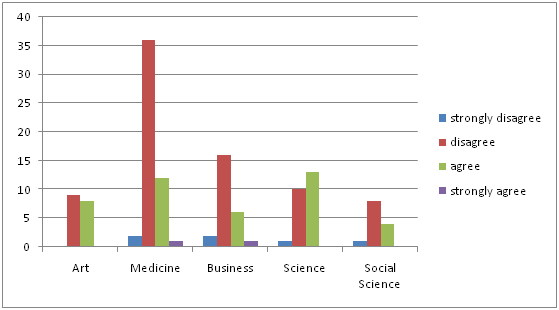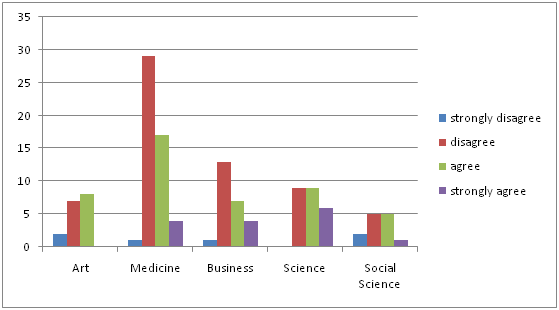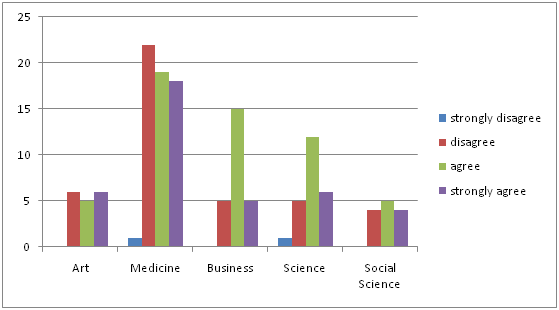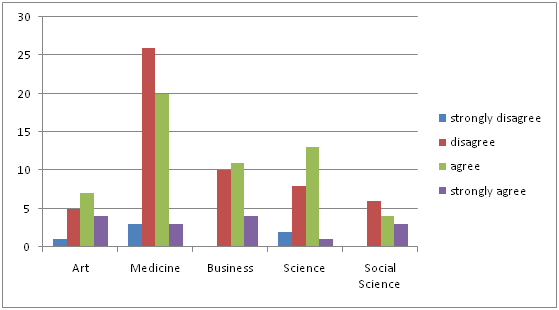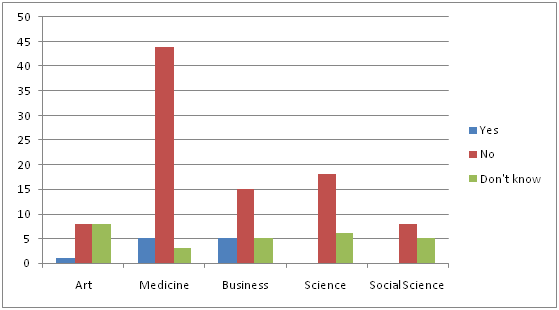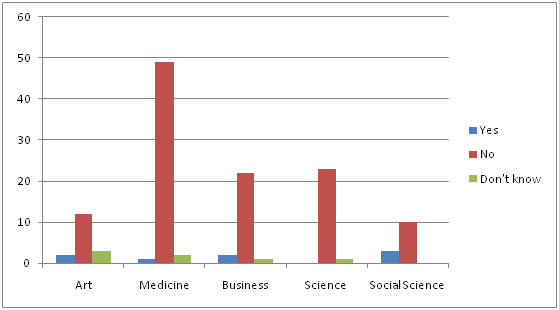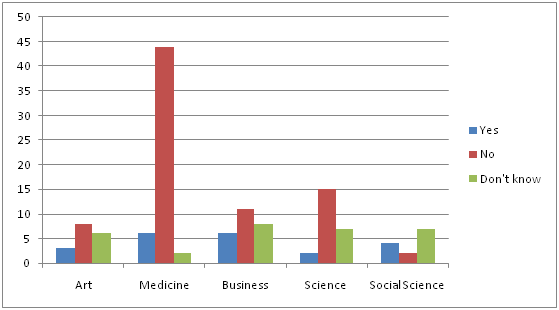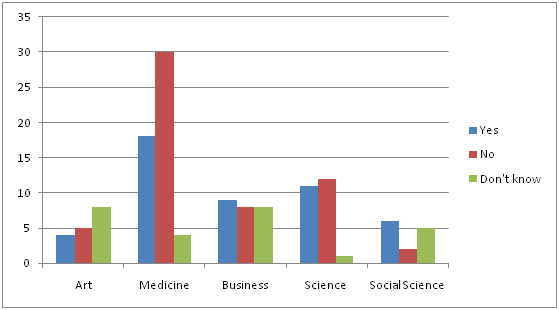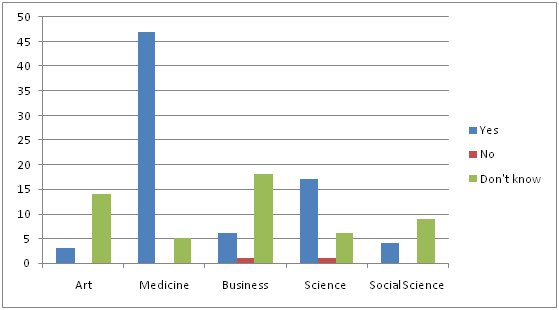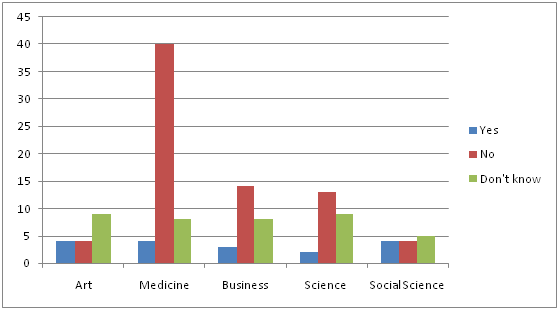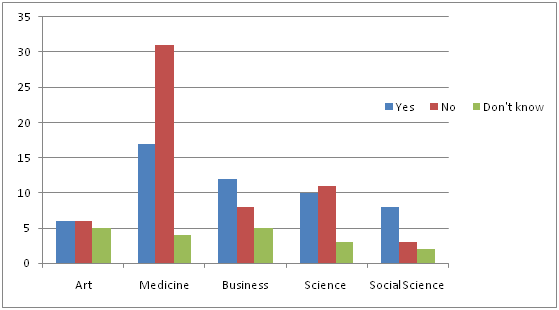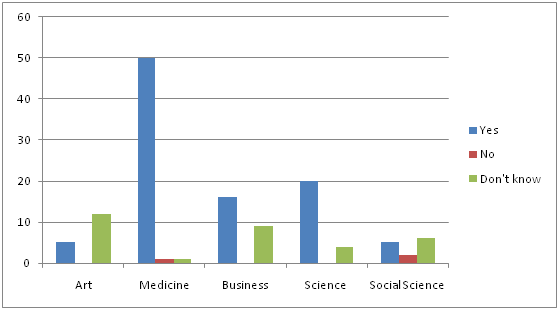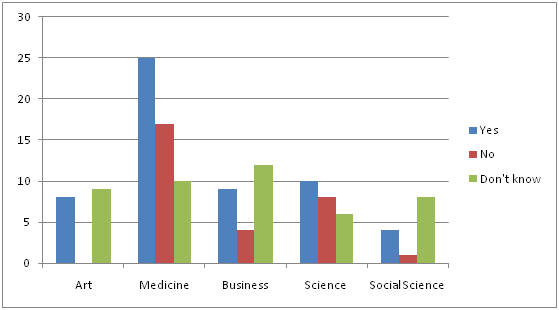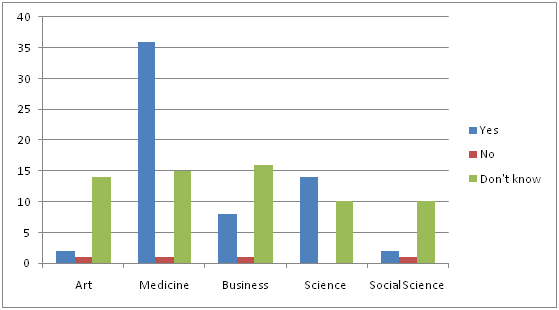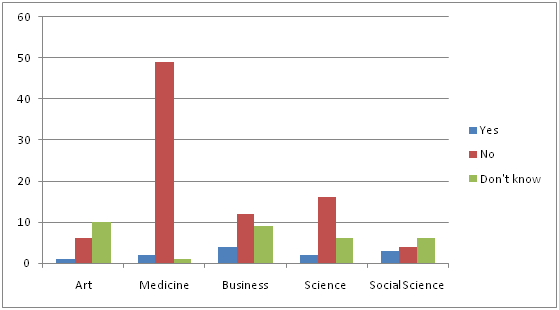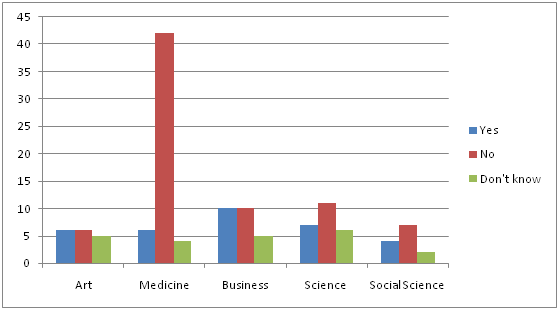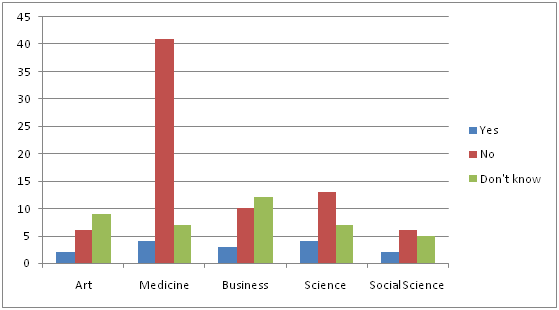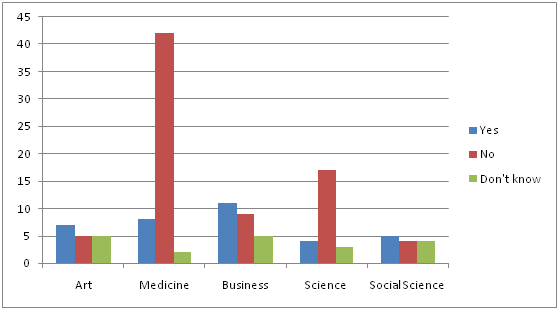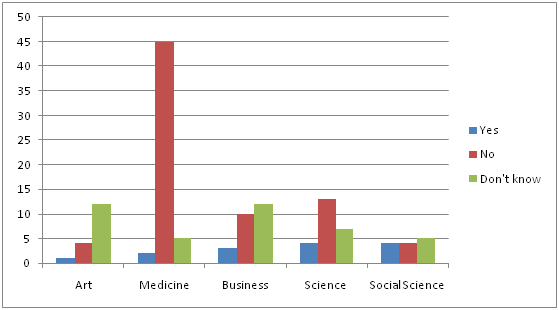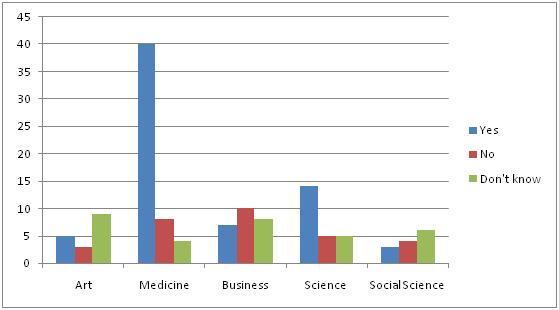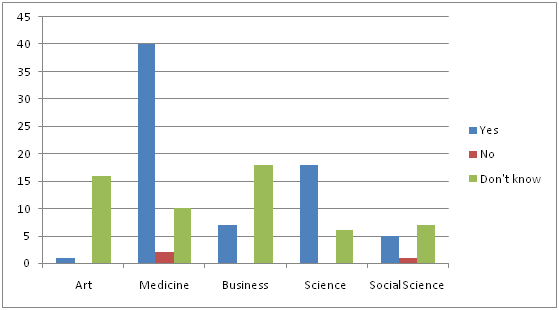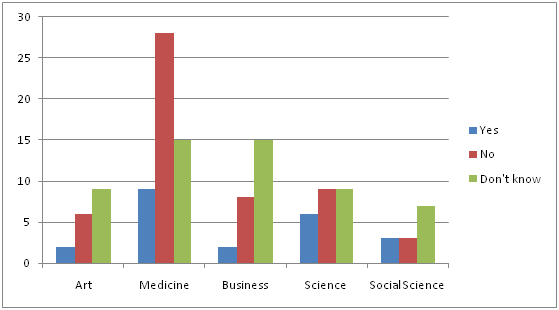Team:HKU-HKBU/human practice findings
From 2009.igem.org
YinanZhang (Talk | contribs) |
YinanZhang (Talk | contribs) |
||
| Line 55: | Line 55: | ||
====Figure 3==== | ====Figure 3==== | ||
| + | Manipulating, inflicting trauma or killing primates (e.g. monkeys) for experimental purpose is morally wrong. | ||
| + | |||
[[Image:HKU-HKBU_human_practice_findings_figure_3.png | center]] | [[Image:HKU-HKBU_human_practice_findings_figure_3.png | center]] | ||
| + | |||
| + | Discussion: | ||
| + | |||
| + | Primates are animals who resemble human beings the most, and in fact a lot of experiment has been done on primates (with or without inflicting trauma) for the sake of understanding human sciences, especially psychology. The majority of university students in Hong Kong, even science students, may be aware of the fact that primates look like human beings, and this resemblance makes them “more humane”, to the extent that they should be respected. | ||
====Figure 4==== | ====Figure 4==== | ||
| + | Manipulating, inflicting trauma or killing mice/guinea pigs for experimental purpose is morally wrong. | ||
| + | |||
[[Image:HKU-HKBU_human_practice_findings_figure_4.png | center]] | [[Image:HKU-HKBU_human_practice_findings_figure_4.png | center]] | ||
| + | |||
| + | Discussion: | ||
| + | |||
| + | The majority of medical students think that manipulating, inflicting trauma or killing mouse/guinea pig for experimental purpose is not morally wrong. Is it possible that they are aware of the fact that mouse/guinea pig are used in many pre-clinical trials of drugs, and without doing so, clinical drugs trials (i.e. on humans) cannot proceed? That indicates manipulating, inflicting trauma or killing mice/guinea pig for drug development is morally acceptable, since this saves human lives. | ||
====Figure 5==== | ====Figure 5==== | ||
| + | Cell types are interchangeable, e.g. muscle cells can become blood cells. | ||
| + | |||
[[Image:HKU-HKBU_human_practice_findings_figure_5.png | center]] | [[Image:HKU-HKBU_human_practice_findings_figure_5.png | center]] | ||
| + | |||
| + | Discussion: | ||
| + | |||
| + | The majority of students hold the belief that cell types are not interchangeable, which is in general correct until now. However, since the discovery of induced pluripotent stem cells, it may be possible in the future that different cell types can be inter-converted through the induction of pluripotency, although lots of researches have to be conducted in order for a conclusion to be made. As a general rule of science, theories may not hold true forever. | ||
| + | |||
| + | A pitfall in interpreting the results is that those who chose “yes” may not actually know about induced pluripotent stem cells. | ||
====Figure 6==== | ====Figure 6==== | ||
| + | If the parent of a child has a inherited disease, the child would have the same disease. | ||
| + | |||
[[Image:HKU-HKBU_human_practice_findings_figure_6.png | center]] | [[Image:HKU-HKBU_human_practice_findings_figure_6.png | center]] | ||
| + | |||
| + | Discussion: | ||
| + | This statement is false. For a child having one parent affected by an inherited disease: | ||
| + | * For autosomal/X-linked dominant disorders with one affected parent, only 50% of the children will be affected. | ||
| + | * For autosomal recessive disorders, both parents are carriers of the disease. | ||
| + | * For X-linked recessive disorders, only half of the male children will be affected, and half of the female will become carriers. | ||
| + | * For Y-linked disorders, only male children are affected. | ||
| + | * For mitochondrial diseases, only females can pass on the disease but not the males. | ||
| + | * For polygenic disorders, there is no clear-cut pattern of inheritance. | ||
====Figure 7==== | ====Figure 7==== | ||
Revision as of 09:13, 14 October 2009
Division for Human Practices Advance - Findings
- In contrast with students from other faculties, the majority of science students agree that Genetically Modified food is harmful.
- In contrast with students from other faculties, the majority of science students agree that genetically modified organisms should be retained in the laboratory setting and should never be released into the wild.
- The majority of all students agree that manipulating, inflicting trauma or killing primates (e.g. monkeys) for experimental purpose is morally wrong.
- In contrast with students from other faculties, the majority of medical students disagree that manipulating, inflicting trauma or killing mouse/guinea pig for experimental purpose is morally wrong.
- Concepts that are well known to non-science, non medical students
- Concepts not well known to non-science, non-medical students
- DNA only exist in the nuclei of cells?
- One of the ways to introduce genes into a bacterium is to introduce a plasmid into it?
- All bacteria are capable of locomotion?
- Gene therapy has already been widely used in modern medicine?
- DNA is made up of 4 types of bases: adenine (A), guanine (G), thymine (T) and cytosine (C)?
- RNA can be genetically inheritable?
- Green florescent protein allows the identification of protein expression?
- Cells communicate with each other by electrical signals only?
- Normal human cells have unlimited replication potential?
- Bacteria cannot exchange their genes among themselves?
- All mutations in DNA have effect(s) on the cell?
- Virus replicate outside the cells.
- The function of genes is to manufacture proteins?
- In synthetic biology, the most commonly used organism is Escherichia coli?
- Concepts not well known to all students
Figures
Figure 1
Genetically modified food is harmful to the human body.
Discussion:
The majority of science students question the safety of genetically modified food, while the majority of students from other faculties do not. In contrast, the majority of medical students (i.e. future health care professionals) do not. We could not think of a satisfactory explanation for this.
Figure 2
Genetically modified organisms should be retained in the laboratory setting and should never be released into the wild.
Discussion:
The majority of science students are aware that releasing GM organisms into the wild may disturb the natural gene pool of the organism, which may then lead to ecological consequences. Students from other faculties are less aware of the consequences.
Figure 3
Manipulating, inflicting trauma or killing primates (e.g. monkeys) for experimental purpose is morally wrong.
Discussion:
Primates are animals who resemble human beings the most, and in fact a lot of experiment has been done on primates (with or without inflicting trauma) for the sake of understanding human sciences, especially psychology. The majority of university students in Hong Kong, even science students, may be aware of the fact that primates look like human beings, and this resemblance makes them “more humane”, to the extent that they should be respected.
Figure 4
Manipulating, inflicting trauma or killing mice/guinea pigs for experimental purpose is morally wrong.
Discussion:
The majority of medical students think that manipulating, inflicting trauma or killing mouse/guinea pig for experimental purpose is not morally wrong. Is it possible that they are aware of the fact that mouse/guinea pig are used in many pre-clinical trials of drugs, and without doing so, clinical drugs trials (i.e. on humans) cannot proceed? That indicates manipulating, inflicting trauma or killing mice/guinea pig for drug development is morally acceptable, since this saves human lives.
Figure 5
Cell types are interchangeable, e.g. muscle cells can become blood cells.
Discussion:
The majority of students hold the belief that cell types are not interchangeable, which is in general correct until now. However, since the discovery of induced pluripotent stem cells, it may be possible in the future that different cell types can be inter-converted through the induction of pluripotency, although lots of researches have to be conducted in order for a conclusion to be made. As a general rule of science, theories may not hold true forever.
A pitfall in interpreting the results is that those who chose “yes” may not actually know about induced pluripotent stem cells.
Figure 6
If the parent of a child has a inherited disease, the child would have the same disease.
Discussion: This statement is false. For a child having one parent affected by an inherited disease:
- For autosomal/X-linked dominant disorders with one affected parent, only 50% of the children will be affected.
- For autosomal recessive disorders, both parents are carriers of the disease.
- For X-linked recessive disorders, only half of the male children will be affected, and half of the female will become carriers.
- For Y-linked disorders, only male children are affected.
- For mitochondrial diseases, only females can pass on the disease but not the males.
- For polygenic disorders, there is no clear-cut pattern of inheritance.
Figure 7
Figure 8
Figure 9
Figure 10
Figure 11
Figure 12
Figure 13
Figure 14
Figure 15
Figure 16
Figure 17
Figure 18
Figure 19
Figure 20
Figure 21
Figure 22
 "
"

